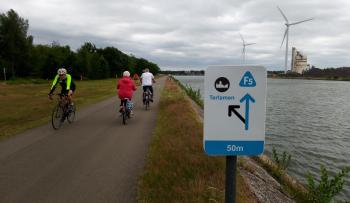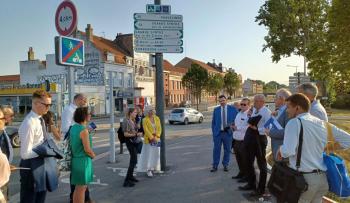
F11 cycle highway: EU funds well used
ECF takes a look at the F11 cycle highway bridge over a TEN-T railway in Belgium as an example of EU funding being well spent. Costing just over than €2 million, the project received an €832,000 subsidy from the European Regional Development Fund.
The F11 cycle highway connects Antwerp (520,000 inhabitants) and Lier (36,000 inhabitants) in Belgium. As many other Flemish cycle highways, this 12 km route is located almost entirely along a major railway line, part of the Trans-European Transport Network (TEN-T). The rail corridor enables a very direct route, with minimal conflicts with motorised traffic. However, because of varying availability of terrain and in order to best serve the towns on both sides of the tracks, the cycle highway needs to switch the side of the railway more or less in the middle of the route.
The switch is possible thanks to a cycle bridge over the railway line, on the border between the municipalities of Mortsel and Boechout, opened in 2020. While the bridge is not as long or expensive as the one over the Brussels ring road, it is perhaps a more typical example of what is needed in thousands of towns and villages across Europe to safely cross major roads or rail lines.
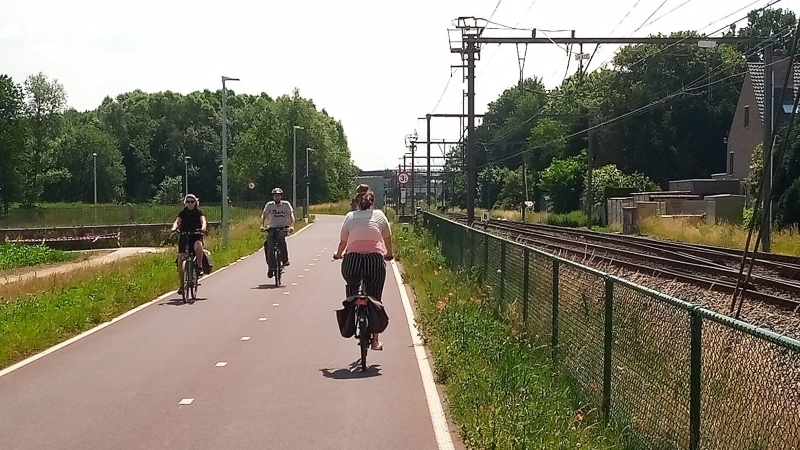
Cycle highway F11 Antwerp – Lier follows a TEN-T railway (Source: Aleksander Buczyński, ECF)

Good design parameters make the route suitable and safe for a wide range of users (Source: Aleksander Buczyński, ECF)
A cycle bridge done right
The cycle track is built in line with the Flemish cycle highway quality requirements, 4 m wide, and with a minimum horizontal curve radius of 35 m. The composite bridge over the railway itself is 27 m long and 5 m wide. The extra width allows to provide a safety clearance of 0.5 m on each side of the cycle track. Ramps lead to the bridge with gentle slopes with around 3% gradient. Victor Heylen lane, the street connecting to the ramp from the Bouchout side, was rebuilt to a cycle street standard, making it clear that cyclists are the main users and cars are guests (from the legal point of view, the Belgian cycle street sign means that the speed is limited to 30 km/h, cyclists are free to use full width of the carriageway, and cars are not allowed to overtake cycles).
The investment costs amounted to a bit more than €2 million. The project received an €832,000 subsidy from the European Regional Development Fund (ERDF), under the "Fostering the transition to a low-carbon economy" priority. The rest was covered by the Flemish government (€800,000) and the Antwerp Province (€448,000).

Aerial view of the bridge and the ramps alignment (Source: Google Maps)
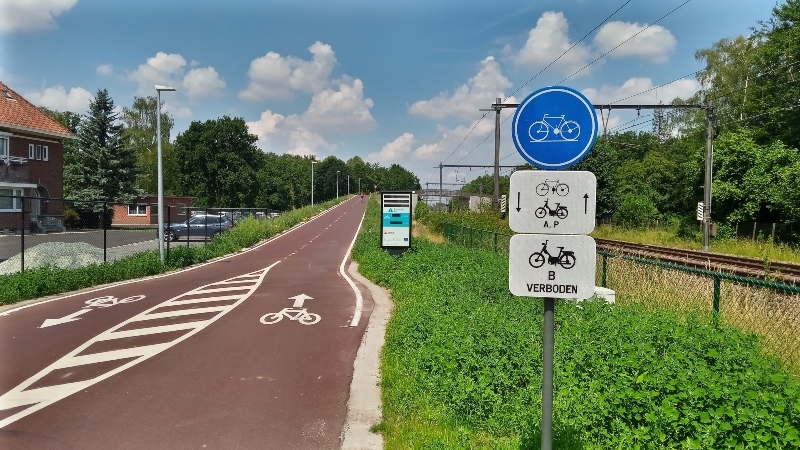
The southern ramp leading to the bridge. High quality of the route allows to tap into the potential of speed pedelecs, who are allowed to use the cycle highway, as indicated by the P letter on the panel under the cycle track sign (Source: Aleksander Buczyński, ECF)
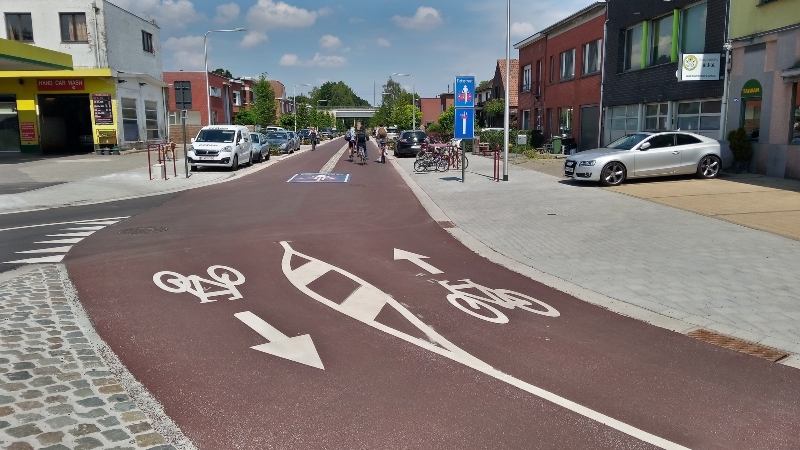
Victor Heylen lane, the street connecting to the ramp from the Bouchout side, was rebuilt to a cycle street standard (Source: Aleksander Buczyński, ECF)
Why is the example important?
Existing TEN-T waterways, railways and roads often form major barriers for cyclists, cutting cities, towns and countryside into isolated areas, making cycle trips unnecessarily long or dangerous. This barrier effect needs to be systematically addressed, which is one of the ECF requests for the current revision of the TEN-T regulation. EU funding will be necessary to remedy some of the harm done by previous, also EU funded, but badly designed projects.
However, often even if there is a good will and funding, there is no technical know-how to design cycling infrastructure. Across Europe we see many examples of bridges or tunnels that were supposed to serve active mobility, but fail because of excessively steep ramps, chicanes, straight-angle or even 180-degree turns, or dangerous crossings at the bottom of the ramps. They are either not used or not safe to use, they create conflicts between different groups users, or social safety issues. Bridges like the one on the F11 cycle highway, with the details worked out right, can serve as a benchmark and inspiration.
Video of F11 Cycle Highway (Source: Antwerpen Fietsprovincie)
See also More information about F11: https://fietssnelwegen.be/fietssnelwegen/f11 EU funding information: https://www.efro-projecten.be/nl/zoek-een-europees-project/fietsostrade-antwerpen-lier-fietsbrug-over-spoorbundel-te-mortsel~72/ Cycling along F11: https://www.youtube.com/watch?v=qOuMxuT0iFc
Cover photo: The bridge over the rail line and the descent towards Antwerp (Source: Aleksander Buczyński, ECF)
Regions:
Contact the author
Recent news!
Upcoming events
Contact Us
Avenue des Arts, 7-8
Postal address: Rue de la Charité, 22
1210 Brussels, Belgium

